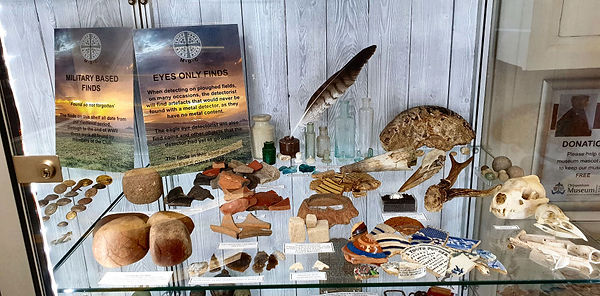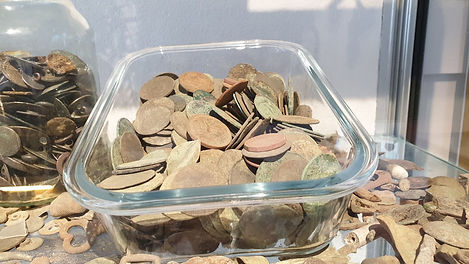CHIPPENHAM MUSEUM
CDMDC DETECTING EXHIBITION
18 January - 19 march 2020
Article by Richard
.jpg)
Since I was a kid, museums have always fascinated me. They are the closest thing mankind will ever get to a time-machine, certainly in my lifetime anyway, therefore I have always tried make the most of visiting them when the opportunity arises. So, when the prospect came up for our club to lay on an exhibition at Chippenham Museum, we jumped at the chance to show off the amazing items we have rescued from the ground over the past few years.

Matt preparing his post-Tudor display
So, the first stage was to allocate responsibility and empower members to coordinate their allocated areas of responsibility; Jon was in charge of the Celtic and Roman display; Mimzy had command of the Middle Ages; Matt was Tudor onwards and the club approached me to tackle the most important part of the display – of junk! It was only fair that we represented the reality of metal detecting, so I proudly agreed to show off my much-admired collection of Moo Tubes, Shotgun Caps, grade B buttons and toasted pennies. All, of course, displayed on a bed of Bits Off A Tractor (to coin a phrase from our much-loved favourite TV series).

Downstairs at the museum entrance, Mimzy oversaw the arrangement of the opening display consisting of a plethora of lead-based finds (musket balls, weights and tokens), militaria, buckles, disclaimed treasure and a host of other awesome artefacts. This dazzling introduction, designed to seize the visitor’s attention, worked wonders as it guided them to the main attraction upstairs. Set in 5 tiers of glass shelving, this display is probably my favourite.
Exhibition Entrance

Downstairs Cabinet
Lead finds are not everyone’s cup of tea but for me each item captures the story of our ancestors using a metal that’s so versatile it was practically everywhere (and probably accounting for 50% of the junk I find!) Had they known the associated health risk of using lead in this manner perhaps we wouldn’t be as connected as we are with the past – and perhaps their life expectancy would have been longer.
Another part of this display was the ‘best finds’ trophy and acknowledgement of the fine charity work the club involves itself it, mainly supporting Wiltshire Air Ambulance. The former is more to satisfy our own egos and introduce a bit of competitive spirit amongst the club members whereas the charity element is, of course, much more important. Since it was established some four years ago the club has held a close relationship with this most worthy cause.

Lead Items

Best Finds Winner Trophies

Support to Wiltshire Air Ambulance
In this cabinet was also something you probably wouldn’t expect to see. Non-metallic items found by field walking! Mimzy – retired soldier-cum-full time detectorist – combines detecting with ‘field walking’, therefore has a huge collection of what I can only refer to as ‘stuff’. Feathers, animal bones, shells, pottery, and so on. If it’s laying on the ground and interesting, it’s in the collection, and rightly so. Let’s not start on his pigeon ring collection….

Mimzy's 'Eyes Only' Finds

Bronze Age to Roman
Moving upstairs into the main exhibition room will see you gasp in awe at Jon’s arrangement of Bronze age, Iron Age and Roman coins and artefacts. A few things will grab your immediate attention; a gorgeous Celtic terret ring, lovingly restored by the conservationists at Salisbury Museum, a beautiful Chatelain Roman brooch and – of course – a shiny gold coin. This one having been found just a few weeks prior to the exhibition event and being an Aureus from the reign of Trajan at the beginning of the second century AD.

Medieval to Tudor
Moving on you come to Mimzy’s display of artefacts and coins that hail back to the Middle Ages. For me this display captures the very essence of our hobby. After all, tell me one detectorist who does not feel butterflies in this or her stomach when they turn over a clod of earth to find a round impression pressed into it and then, during the frantic search of looking for what made that round dent, pulls a shiny silver hammered coin from the hole. These coins have held a personal fascination for me ever since finding my very first medieval coin in the form of an Edward IV Groat. Since then I have accumulated a collection of about 30 over my 3 years detecting, with the latest being an early 13th Century Short-Cross penny from the reign of King John.
The display also shows an extraordinary range of other items; from heraldic pendants that could have once adorned the tack of a mighty steed, to a purse bar of some unlucky country gentleman who later cursed himself for not looking after his money. Then there’s the buckles. Plenty of people back then went home after a long day working the field with a loose shoe or falling trousers. But what about the arrow heads? Was the Tudor bodkin loosed from the bow in anger or was it a missed hunting opportunity? We’ll never know, but we can dream.

Post-Tudor
Next along, Matt has done the club and the museum proud with his awesome arrangement of post-Tudor items. My attention always gets drawn to the buttons and the vast selection of types, sizes and inscriptions that lay in the fields, particularly regimental fasteners. I remind myself that, back then, zips and Velcro didn’t exist which puts things into perspective a little better. We also sometimes forget out militarised past; a huge proportion of the population was mobilised in the two world wars, something we probably struggle to comprehend nowadays. I also hear – but cannot substantiate - that, when our vast armies were demobilised, uniforms were shredded and used to fertilise the land which would explain their abundance.
We also perhaps forget that, prior to mechanisation in the 18th and 19th century, horses were the engines of field work. It makes sense then, that equine finds crop up regularly and paint – for me anyway - a vivid picture of rural living. Together, I see menfolk driving the horse-drawn plough, whilst the wives are at the side of the field, darning clothes (and occasionally dropping their thimbles whilst doing so). I see the wealthy landowner monitoring progress from the side lines and then, at the end of the day, pulling out his purse and handing over the pennies in pay for a hard day’s labour. The landowner, of course, keeping the gold sovereigns to lose later – and for me to find tomorrow.
Moving on to the final glass cabinet, some of which – I’m proud to say – was down to me. You see, I am expert at acquiring some things so, readers, prepare to control your envy. For I have mastered the art of accumulating Moo Tubes and Shotgun Caps. It’s taken me almost 3 years to hone this particular skill and the results are clear, so if anyone needs tips, I’m your man.

The Reality of Detecting

Scrap Metal

Toasted & Modern Coins
Actually, we decided to include the ‘reality’ of detecting to stamp out the myth that the hobby is not all gold coins, silver rings and hordes of Bronze Age axes. It is predominantly items like this, along with huge amounts of scrap lead, iron and farming equipment. It takes patience, perseverance, good land, luck and an understanding of your detector - irrespective of its age, brand or perceived capability, to find real treasure. And by treasure, I mean of historical, not monetary, value. Toasted coins can also be a frustration and I often find myself asking why our ancestors were so inconsiderate in losing their money. They should have lost more silver and gold coins in my humble opinion.
Of course, looking at old stuff is not to everyone’s taste, especially if you’re 5 years old. The cater for these future detectorists we put out a sand pit and hid some old coins, challenging them to find them with a pin pointer. Finders keepers! Needless to say, the club’s stock of pre-decimal pennies, sixpences, and florins has now been decimated (pun intended) but the children walked away with a smile, an experience and a piece of history. They took home with them a club activities book which included puzzles and pictures to colour in as part of a competition they can enter.

A Potential Future Detectorist

The Mayor of Chippenham Tries Her Hand
A special Open Evening was held in February and was attended by many of our landowners alongside guests that included the Mayor of Chippenham and the Wiltshire Finds Liaison Officer (and good friend of the club), Wil Partridge. We extend our thanks to Wiltshire Council, specifically Chippenham Museum and the staff led by Melissa who have been key to providing us the support we needed to make the exhibition successful. Attendance was recorded in the thousands with a notable increase in donations for the museum by attendees. We look forward to continuing our relationship with Wiltshire museums, local councils and the county archaeologists in order to promote a deeper understanding of our history and local heritage.
A note from Wil Partridge, Finds Liaison Officer (FLO) for Wiltshire
“The recent display put on by the Chippenham and District Metal Detecting Club at Chippenham Museum was a testament to the enthusiasm and dedication of its club members to their hobby. The display, which I understand to have been very popular, was an impressive collection of artefacts and a good example of a club proactively seeking to engage with a local heritage body. Members stressed the legal responsibilities and issues relating to responsible metal detecting through interactive activities and the exhibition also ended up as a catalyst for engagement with the local YAC and other groups. Ultimately, a very positive first step and hopefully we will be able to see more in the future.”
